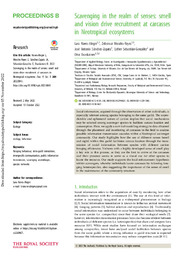Please use this identifier to cite or link to this item:
https://hdl.handle.net/11000/33921Full metadata record
| DC Field | Value | Language |
|---|---|---|
| dc.contributor.author | Naves Alegre, Lara | - |
| dc.contributor.author | Morales-Reyes, Zebensui | - |
| dc.contributor.author | Sánchez Zapata, José Antonio | - |
| dc.contributor.author | Sebastián-González, Esther | - |
| dc.contributor.author | Ovaskainen, Otso | - |
| dc.contributor.other | Departamentos de la UMH::Biología Aplicada | es_ES |
| dc.date.accessioned | 2024-11-19T10:02:19Z | - |
| dc.date.available | 2024-11-19T10:02:19Z | - |
| dc.date.created | 2022-11-09 | - |
| dc.identifier.citation | Proceedings of the Royal Society B: Biological Sciences, 2022, Volume 289 Issue 1986 | es_ES |
| dc.identifier.issn | 1471-2954 | - |
| dc.identifier.issn | 0962-8452 | - |
| dc.identifier.uri | https://hdl.handle.net/11000/33921 | - |
| dc.description.abstract | Social information, acquired through the observation of other individuals, is especially relevant among species belonging to the same guild. The unpredictable and ephemeral nature of carrion implies that social mechanisms may be selected among scavenger species to facilitate carcass location and consumption. Here, we apply a survival-modelling strategy to data obtained through the placement and monitoring of carcasses in the field to analyse possible information transmission cascades within a Neotropical scavenger community. Our study highlights how the use of different senses (smell and sight) within this guild facilitates carcass location through the transmission of social information between species with different carrion foraging efficiencies. Vultures with a highly developed sense of smell play a key role in this process, as they are the first to arrive at the carcasses and their presence seems to serve as a visual cue for other species to locate the resource. Our study supports the local enhancement hypothesis within scavengers, whereby individuals locate carcasses by following foraging heterospecifics, also suggesting the importance of the sense of smell in the maintenance of the community structure. | es_ES |
| dc.format | application/pdf | es_ES |
| dc.format.extent | 8 | es_ES |
| dc.language.iso | eng | es_ES |
| dc.publisher | The Royal Society | es_ES |
| dc.rights | info:eu-repo/semantics/openAccess | es_ES |
| dc.rights | Attribution-NonCommercial-NoDerivatives 4.0 Internacional | * |
| dc.rights.uri | http://creativecommons.org/licenses/by-nc-nd/4.0/ | * |
| dc.subject | foraging behaviour | es_ES |
| dc.subject | intra-guild interactions | es_ES |
| dc.subject | interspecific communication | es_ES |
| dc.subject | public information transmission | es_ES |
| dc.subject | scavenging assemblages | es_ES |
| dc.subject | species networks | es_ES |
| dc.subject.other | CDU::5 - Ciencias puras y naturales::57 - Biología | es_ES |
| dc.title | Scavenging in the realm of senses: smell and vision drive recruitment at carcasses in Neotropical ecosystems | es_ES |
| dc.type | info:eu-repo/semantics/article | es_ES |
| dc.relation.publisherversion | https://doi.org/10.1098/rspb.2022.0843 | es_ES |

View/Open:
38.pdf
767,39 kB
Adobe PDF
Share:
.png)
